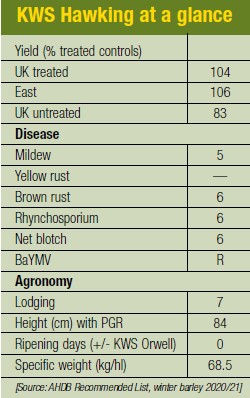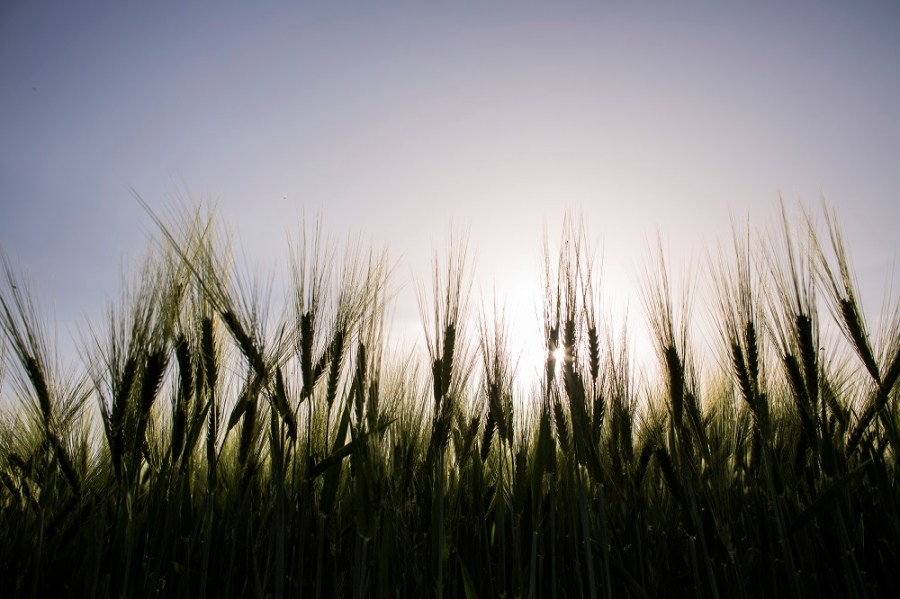With two decades of breeding behind it, there’s a new contender on the feed barley market. CPM reviews KWS Hawking.
It could easily become the leading two-row variety in the short to mid-term.
By Charlotte Cunningham
It’s been nearly 20 years since Cassia broke the winter barley mould, but now, four generations later, there’s a new horse from the same stable: KWS Hawking, the firm’s latest high yielding two-row feed barley.
KWS Hawking is the progeny of a three-way cross between quarter parents, 11-12 and LG California and half parent, Tower. This combination comes as a result of the old breeders’ adage of mixing the best with the best and hoping for the best, says David Harrap, breeder at KWS. “11-12 was almost an entry for us in 2012. It was a Cassia cross type and if we’d had an extra slot it would have been our next variety. LG California was quite a nice new thing too; with good traits such as yield and earliness.
“Tower, at the time, was the number one variety and had proved to be a good parent, so it was all about mixing up this good pool of genetics.”
With 30 years of breeding under his belt, David says the biggest breakthrough in that time was the launch of Saffron in the early 2000s and everything else since then – including KWS Hawking – has been an improved version of the old favourite, tweaked to boost performance. “Saffron kickstarted our breeding programme here at KWS, and since then we’ve had Cassia, Tower, Orwell and now Hawking which are all based on the strength of that variety.
“You put more diverse material into your breeding programme so that you’re not always picking on type, but this is what kept popping up in terms of having the ideal combinations of characteristics.”
While the variety itself may not be too distant from its predecessors, what has changed massively in that time are the breeding techniques, explains David. “It used to be all about muddy boots in the field all summer and part of the winter. We’d be crossing in the greenhouse and growing in the field, hoping something good would pop up.
“In 2004, molecular markers began to be used which really helped us to be much more accurate and accelerate our breeding programmes, meaning we’ve been able to bring through specific traits – like the stiffness and yield in KWS Hawking – to the market much more quickly.”
KWS Hawking’s level-up in terms of breeding is credit to David’s strategic approach over the past 30 years, says John Miles product development manager at KWS. “David is like a racehorse trainer with three or four winners in his stable and KWS Hawking is the next generation of winter barley that ticks a few boxes that others didn’t.”
According to John, the stand-out feature of the variety is its stem strength. “Stem strength is an area that varieties across the board have been a bit weaker on, but from my experience it’s something that farmers are looking for more as it really effects harvesting efficiency.
“It’s the same for agronomists – I often think that weak straw is like kryptonite to them – no one wants flat crops.”
While the variety is recommended for the whole of the UK, it’s claimed to perform exceptionally well in the East where in KWS trials, it has recorded its best performances to date, explains John. “The AHDB Recommended List figures show 104% in the UK and an impressive 106% in the East. Orwell had a UK yield of 101.5% so there’s an obvious improvement there.”
With competitors such as Gimlet, Orwell and LG Mountain on the market too, does KWS Hawking really offer anything different? According to John, yes. “If you take a look at the mildew score, for example, with a rating of 5, it’s much better than Orwell that had a score of just 3.”
“Gimlet also had some issues with straw so there’s an improvement here too.”
Compared with LG Mountain, KWS Hawking also has an advantage in terms of lodging, he adds.
So what kind of grower might it be suited to? “The higher yields in the East will no doubt appeal to growers in that region, but in general, it’s a really good-all-round two-row feed variety,” explains Kirsty Richards, value chain manager at KWS. “It boasts a strong set of agronomic features, with no disease weaknesses and resistance to Barley yellow mosaic virus (BaYMV).”
According to the RL, KWS Hawking scores a 6 for rhynchosporium, brown rust and net blotch, which should help give growers some reassurance and flexibility in terms of disease control, she adds.
In addition, it’s a mid-length strawed type which has good resistance to lodging and is also earlier to mature, says Kirsty. “In our own KWS UK trials over the past two seasons, the variety has been significantly ahead of its stablemates in reaching ear emergence in May.”
According to Kirsty, growers who like varieties such as Orwell and Cassia are likely to find comfort with KWS Hawking. “It’s a low-risk variety, with no real weaknesses. So for those looking for something new, this seems like a natural progression.”
From a merchant’s perspective, Simon Minns of North Yorks-based grain and seed merchants James Mortimer, believes Hawking will have considerable appeal to growers and the trade with the potential to become the leading two-row barley variety in some regions.
“Hawking is a logical step forward for many producers as it offers the same short straw length as Orwell to provide security of harvest, but with yields on a par with Gimlet. It’s the best of both worlds.
“I can see a lot of Orwell growers moving over to Hawking but there will also be those from other varieties as it doesn’t require the same attention to detail around PGR use as others and that’s a big bonus for many.”
The trade will take to it very quickly, too, not just because of the variety’s versatility and performance but also as its appeal is easy for growers to understand, he adds.
“It’s the complete all-round package. A strong variety from a well-recognised and successful breeding programme allied to class-leading security of harvest, high yield and improved disease resistance.
“I honestly don’t think there are too many drawbacks with Hawking, and I imagine it will be in demand from mixed farmers and purely arable producers, alike.
“I wouldn’t be surprised if it builds considerable market share quite rapidly and in an important barley growing area such as ours, it could easily become the leading two-row variety in the short to mid-term.”
North Yorks grower, Derek Cornforth is a long-standing supporter of KWS varieties and has, in fact, grown 90% of KWS’ two-row and six-row varieties on his chalky soils at East Heslerton Wold Farm – KWS’ product development trials site.
But after being particularly impressed with KWS Hawking in his trial plots last season, he’s selected the variety as his commercial crop this year.
“Every year, the newest variety has been a little bit better yielding than its predecessor,” explains Derek. “In this part of the world, Cassia has always been our benchmark for quality and performance, but Hawking has proven to be slightly better for us – mainly due to earlier maturity and higher yields.”
In his trials last year, KWS Hawking produced an impressive 1.5t/ha more than Cassia – with a total yield of 10.7t/ha (based on a 1ha trial plot), he adds.
With altitude being a key factor for consideration when it comes to selecting commercial varieties, ensuring good straw strength and yield are top priorities, he adds. “Our height above sea level means we often drill at a quite high seed rate – over 400 seeds/m² – so having good standing power embedded in the variety really helps.”
“Spring comes a lot later here too so having something that’s a bit earlier to mature is really advantageous.”
Straw quality is also really important, adds Derek. “Our barley straw goes for horses or is processed for small animal bedding, so it’s crucial that the variety allows us to supply those outlets.”
Agronomy wise, Derek uses a basic broad-spectrum programme, and says there’s nothing particularly to be aware of in terms of managing the variety. “KWS Hawking is just what we need in a commercial variety – it’s a great all-rounder.”
Standing up to hybrid performance
New two-row barley variety introductions appear to be closing the performance gap on the hybrid six-rows, reckons John. “Due to an earlier sowing date compared with wheat, barley and blackgrass competition is a real factor to consider,” he explains. “On this front I think there are two ways round the issue – you can use a very vigorous continental hybrid, but because of the lower seed rates it means you’re sometimes restricted on plant numbers, leaving gaps for blackgrass to move into.”
“In my opinion, a more effective approach would be to optimise a conventional two-row variety that moves early in the spring – with the caveat of a seed rate of 350+ seeds/m²– to make a carpet of barley so that the blackgrass doesn’t get through.”
With a UK yield of 104%, according to AHDB figures, conventional types are slowly catching up with their hybrid alternatives, adds David. “Something like Bazooka has a yield of 106% so every year and with every variety, we’re getting a little bit closer to matching hybrid yields.”
To grow, or not to grow?
With feed barley futures currently trading at a large discount to feed wheat, it would be negligent not to address the concerns over the value of growing winter barley. However, John believes there is more to take into consideration that just the price per tonne of harvested crop. “Barley is a bit of a Cinderella crop – the commodity price always trades at a deficit to wheat. But it’s actually a much cheaper crop to grow, with roughly half to three quarters less spend on fungicides than wheat. It’s all about thinking about where it might fit in with your system.”
While the economics around barley represent one of the biggest challenges, there are rewards to be reaped in terms of straw value and the role the crop can play in helping spread out workload, he adds. “If you grow winter barley, you’re more likely to get a good early entry for following OSR crops and given that you can drill earlier, it can be really advantageous for those with a heavy workload in that key autumn drilling window.”





